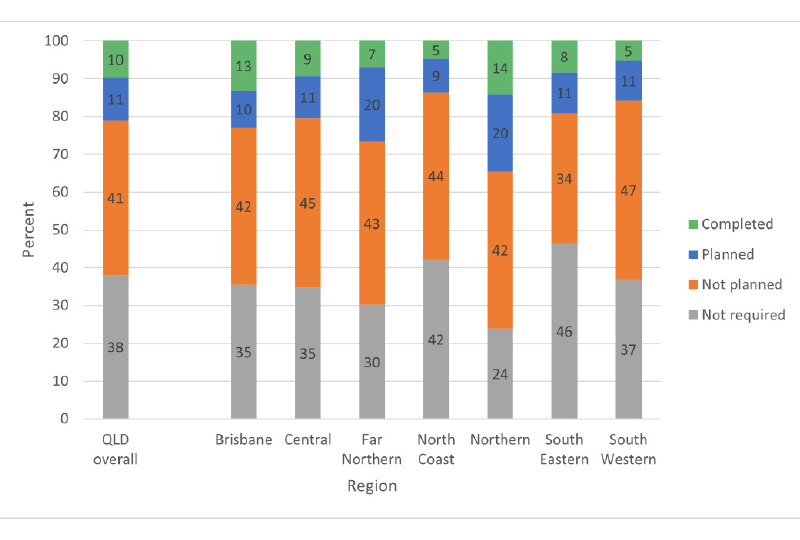Only a small percentage of Queenslanders have thought about how they would access sandbags during a flood event. Could better understanding of sandbag services delivered help them plan and prepare?
The 2022 South East Queensland flood event was a highly visible reminder of the effects of heavy rainfall and the role that sandbagging of at-risk properties can play in mitigation. Emergency services agencies are often involved in the provision of sandbags to community members and there is value in understanding community awareness of this important service.
Queensland Fire and Emergency Services (QFES) conducts an annual community insights survey exploring a range of emergency and disaster events, community perceptions of risk and preparedness and service delivery and expectations of the department. The survey has been run in its current format and approach since 2018 and includes scope to capture perspectives from Queensland’s geographically dispersed population.
While the questions within the survey largely remain the same from year to year, there is scope to add or alter questions when the need arises. With the annual review of survey questions following the 2022 rainfall and flood event, the importance of better understanding sandbag usage, awareness and preparedness was highlighted for inclusion.
Accordingly, questions targeting the following areas were asked:
- Have you received sandbags from QFES in the last 12 months?
- Were sandbags provided by QFES in your local area in the last 12 months?
- Has sandbag preparation or access been conducted/planned to be conducted by you or your landlord to reduce or prevent the impact of an emergency or disaster event?
Methodology
QFES community insights surveys are delivered online by a market research company, IPSOS, to Queensland residents over the age of 18 years.1 The final number of respondents for the 2022 survey was 2,099 and this was evenly distributed across the 7 QFES regions that cover the state. The sample was ultimately weighted to reflect the state's population in terms of region, age and gender.
Sandbag access and provision: what is happening in local areas?
The percentage of respondents who reported receiving a sandbag service from QFES in the preceding year varied across the state:
- Brisbane Region – 13%
- Central Region – 6%
- Far Northern Region – 8%
- North Coast Region – 6%
- Northern Region – 16%
- South Eastern Region – 7%
- South Western Region – 7%.
The figure for across Queensland was 9%.
Responses varied when community members were asked whether QFES had delivered sandbag services in their local area, even if they had not directly received a sandbag. Figure 1 presents responses for each of the regions. The strongest affirmative response was given in Brisbane Region, with 43% of respondents indicating that they were aware that QFES had provided sandbags in their local area. Interestingly, one of the most notable findings was that a large amount of uncertainty existed across each of the regions, with people indicating that they were unsure as to whether QFES had provided sandbags.

Figure 1: Responses to the survey question: Were sandbags provided by QFES in your local area in the last 12 months?
Preparedness and planning
The 2022 Community Insights Survey also captured sandbag preparedness and planning activities undertaken by community members. Figure 2 firstly shows variability in both ‘Completed’ and ‘Planned’ sandbag preparedness activities across the QFES regions. Of note is the significant proportion of respondents who said they had not engaged, nor did they conduct planning to engage, in sandbag access or preparedness (the ‘Not Planned’ category). This is of particular importance as this does not simply represent people for whom sandbags are not required due to the location of their property. These people were captured under the ‘Not required’ response option. Accordingly, the results indicate that there is an appreciable slice of the community that may one day need sandbags to mitigate inundation but have limited planning and self-sufficiency around this activity. It is reasonable to assume that these would be community members who relied on emergency services agencies to provide this service at the time of need.

Figure 2: Responses to the survey question: Has sandbag preparation or access been conducted/planned to be conducted by you or your landlord to reduce or prevent the impact of an emergency or disaster event?
Implications
With the increasing number, frequency and intensity of high-risk events comes a broader spectrum of community members who will be affected, including people who rarely or have never experienced such events before. Distributed across Queensland is a significant proportion of the population whose property may require sandbagging one day but who have not yet conducted or, in many cases, not even planned sandbag preparedness activities. This lack of action may result in more reactive behaviours at the time of a flooding event that could have flow-on consequences for resourcing and logistics of emergency services agencies.
When considering these preparedness findings together with the significant amount of community uncertainty around actual agency sandbag services delivered in local areas, a theme of the prominence of sandbag services emerges. Community members may benefit from better understanding the amount, demands and challenges of delivering sandbags by agencies in their local areas. This may help to improve their preparedness activities that, in addition to personal benefit, may alleviate drawing on emergency services during the acute demands of an emergency response.


